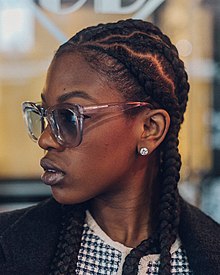
Cornrows (also called canerows) are a style of three-strand braids in which the hair is braided very close to the scalp, using an underhand, upward motion to make a continuous, raised row.[1] Cornrows are often done in simple, straight lines, as the term implies, but they can also be styled in elaborate geometric or curvilinear designs. They are considered a traditional hairstyle in many African cultures, as well as in the African diaspora.[2][3][4] They are distinct from, but may resemble, box braids, Dutch braids, melon coiffures, and other forms of plaited hair, and are typically tighter than braids used in other cultures.[5]
The name cornrows refers to the layout of crops in corn and sugar cane fields in the Americas and Caribbean,[1][6] where enslaved Africans were displaced during the Atlantic slave trade.[7] According to Black folklore, cornrows were often used to communicate on the Underground Railroad and by Benkos Biohó during his time as a slave in Colombia.[8] They often serve as a form of Black self-expression,[9] especially among African Americans,[1] but have been stigmatized in some cultures.[4][10] Cornrows are traditionally called "kolese" or "irun didi" in Yoruba, and are often nicknamed "didi braids" in the Nigerian diaspora.[11]
Cornrows are worn by both sexes, and are sometimes adorned with beads, shells, or hair cuffs.[1] The duration of braiding cornrows may take up to five hours, depending on the quantity and width.[12] Often favored for their easy maintenance, cornrows can be left in for weeks at a time if maintained through careful washing of the hair and natural oiling of the scalp. Braids are considered a protective styling on African curly hair as they allow for easy and restorative growth; braids pulled too tightly or worn for longer lengths of time and on different hair types can cause a type of hair loss known as traction alopecia.[13]
- ^ a b c d "cornrow (noun)". Oxford English Dictionary. Retrieved 27 February 2024.
- ^ Baron, Robert (2010). "Sins of Objectification? Agency, Mediation, and Community Cultural Self-Determination in Public Folklore and Cultural Tourism Programming". The Journal of American Folklore. 123 (487): 63–91 (89). doi:10.5406/jamerfolk.123.487.0063. ISSN 0021-8715.
- ^ Essah, Doris S. (2008). Fashioning the Nation: Hairdressing, Professionalism and the Performance of Gender in Ghana, 1900-2006 (Thesis thesis). p. 221.
- ^ a b Leong, Nancy (2021). "Enjoyed by White Citizens" (PDF). Georgetown Law Review. 109 (1421): 1430.
- ^ Underwood, Khalea (24 August 2019). "Cornrows, Braids, Twists, Oh My: How To Spot The Difference In Braiding Styles". Refinery29. Retrieved 27 February 2024.
- ^ Charlotte Mensah (29 October 2020). Good Hair: The Essential Guide to Afro, Textured and Curly Hair. Penguin Books Limited. p. 42. ISBN 978-0-241-98817-6.
- ^ Quampah, B., Owusu, E., Adu, V. N. F. A., Agyemang Opoku, N., Akyeremfo, S., & Ahiabor, A. J. (2023). "Cornrow: a medium for communicating escape strategies during the transatlantic slave trade era: evidences from Elmina Castle and Centre for National Culture in Kumasi". International Journal of Social Sciences: Current and Future Research Trends (IJSSCFRT), 18:1. pp. 127-143.
- ^ Irbahim, Nur (12 March 2022). "Did Braiding Maps in Cornrows Help Black Slaves Escape Slavery?". Snopes. Retrieved 27 February 2024.
- ^ Dash, Paul (31 January 2006). "Black hair culture, politics and change". International Journal of Inclusive Education. 10 (1): 27–37. doi:10.1080/13603110500173183. ISSN 1360-3116.
- ^ Spellers, R. E. (2000). Cornrows in corporate America: Black female hair/body politics and socialization experiences in dominant culture workplace organizations. Arizona State University. p.iii.
- ^ Kia, Kara (5 February 2021). "It's Time We Ditch the Words "Cornrows" and "Canerows" and Call Them Didi Braids Instead". POPSUGAR Beauty UK. Retrieved 29 February 2024.
- ^ "Cornrow Braid Styles". Africanamericanhairstyling. Archived from the original on 26 July 2018. Retrieved 11 August 2018.
- ^ "Braiding 'can lead to hair loss'". BBC News. 24 August 2007. Retrieved 30 April 2010.